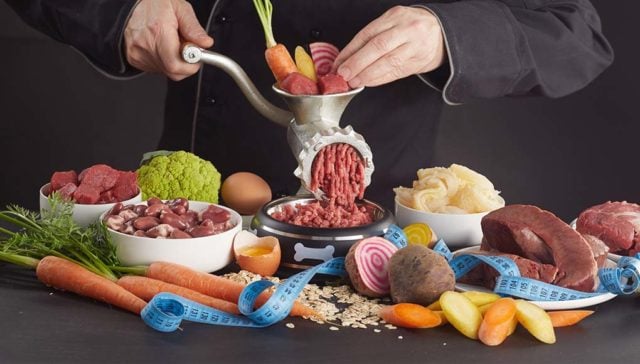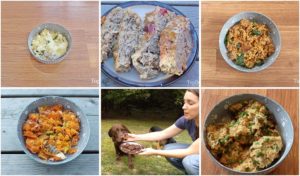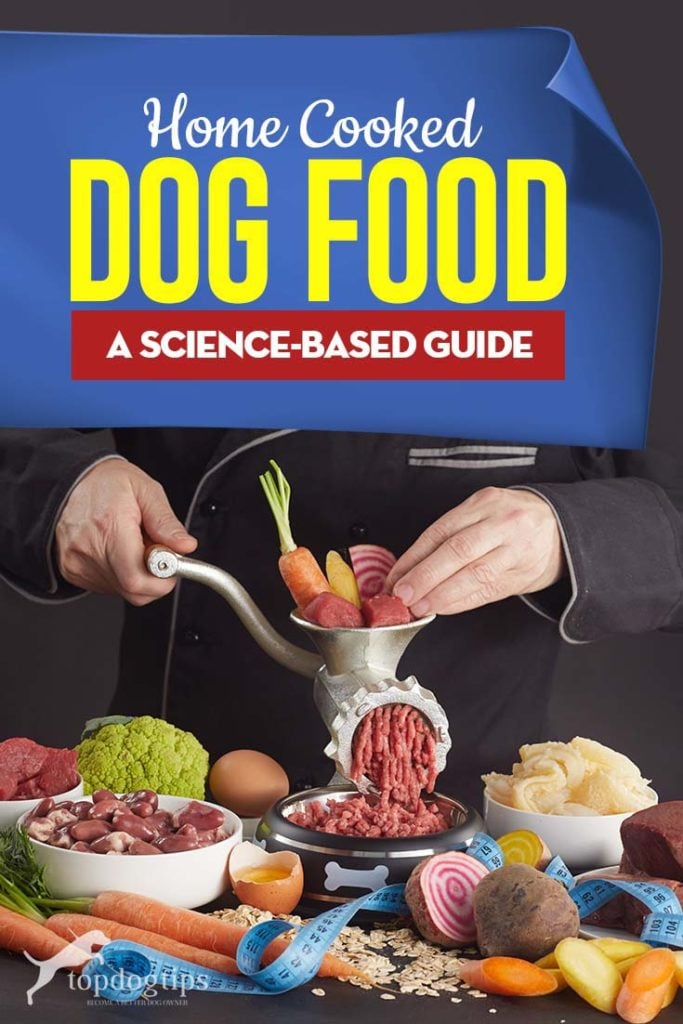
Table of Contents
Covering the subject of homemade dog food recipes is a big part of Top Dog Tips.
Today, though, we’re breaking out the lab coats and talking about canine nutrition and home-cooked dog food recipes in terms of scientific data.
We’re looking at what the past 25 years of scientific data suggests is the best balance of nutrients to ensure that your dog is getting all they need from their home-cooked diet.
If you're looking for recipes, you'll find over 100 of them here. We have also written a few articles in the past that talk about home cooking for dogs in detail:
- 6 Nutritional Guidelines for Safe Homemade Dog Food Cooking
- 25 Vet-Approved Homemade Dog Food Recipes
- 12 Most Common Questions I’m Asked About Homemade Dog Food
- My Top 10 Most Common Homemade Dog Food Ingredients
The list goes on for some 17 pages of our site and includes a huge number of free home-cooked dog food recipes as well as tips for home cooking for your dog.
Why Choose Home-Cooked Dog Food?
Why do pet parents choose home cooking over prepared commercial pet foods, particularly when home cooking seems much more expensive and time-consuming?
There are many reasons why people choose to make home-cooked dog food for their pets, but a few of the most common include:
- Saving money – if they have access to more affordable ingredients or if their dog has allergies, home cooking can be a cheaper feeding option.
- A distrust of commercial pet food companies is hardly surprising after repeated dog food contamination recalls over the past 15 years.
- A belief that home-cooked dog food is a healthier or more natural way for their dog to eat.
Whatever the reason you might have for considering home-cooked dog food recipes, know that it still requires a proper education in canine nutrition.
While the homemade approach can sometimes be healthier for pets, doing it incorrectly will actually be the opposite.
Understanding Canine Nutrition
In the following section, we will be referencing the most recent publication on pet nutrition released by the National Research Council of the National Academies.
The information in this publication is compiled by the Committee On Nutrient Requirements Of Dogs And Cats and is the result of reviewing and summarizing “thousands of scientific papers published on cat and dog nutrition over the past 25 years and makes science-based recommendations on specific nutrient requirements.” (NationalAcademies.org)
Protein and Amino Acids
The general principle of protein consumption/breakdown and the utilization of amino acids for humans and dogs is the same for a home-cooked diet.
Protein is made up of smaller “building blocks” called amino acids.
These amino acids are joined together in chains, and depending on the source of protein, the length of these amino acid chains can be short, long, or somewhere in the middle.
When your dog consumes protein (e.g., from the chicken breast), the stomach secretes enzymes called protease that break down that protein into amino acids.
These amino acids are utilized by the dog's body to build the protein that cells require for the growth, maintenance, and repair of tissue.
For example, the dog's body would use protein to grow and repair nails, hair, and damaged muscle tissue.
Amino acids aren’t just used to build proteins in the body, though; they are also used to create enzymes and hormones that are needed for a dog's everyday function.
Understanding amino acids
There are hundreds of different amino acids found in nature, but only twenty-two of those amino acids are necessary for dogs to consume and live on.
These 22 different amino acids are broken down into essential, conditionally essential, and non-essential amino acids.
An essential amino acid is one that the canine body cannot make or cannot be made at the needed rate. You must supplement these amino acids through commercial or homemade dog food.
A conditionally essential amino acid is usually not an essential amino acid, but that becomes essential when the animal goes through stress or illness.
A non-essential amino acid is produced by the canine body and does not have to be supplemented through any foods.
Although all life depends on these amino acids, the essential and non-essential amino acids for each can differ.
For example, there are 9 essential amino acids for humans, whereas dogs have 10 essential amino acids.
10 essential amino acids for dogs
The ten essential canine amino acids are those that you must supplement to your dog through a commercial or home-cooked dog food diet, and they include:
- Arginine
- Histidine
- Isoleucine
- Leucine
- Lysine
- Methionine
- Phenylalanine
- Threonine
- Tryptophan
- Valine
Amino acids and home-cooked dog food recipes
Since your dog cannot make these ten essential amino acids in its body, it’s up to you to supplement them through home-cooked dog foods.
All of these amino acids must be sufficiently supplemented through diet for your pet to be healthy.
The best way to do this is to incorporate various high-quality fresh proteins into your dog’s home-cooked meals.
Animal muscle meats, organs, eggs, and fish are excellent sources of protein and amino acids. However, you should be wary of overfeeding certain organs since they can lead to toxicosis.
For example, the liver is particularly high in vitamin A and overfeeding can lead to an overdose of vitamin A in dogs.
It’s also worth noting that home cooking methods, cook time, and the type of protein being cooked also influence amino acid levels in proteins.
Although surprisingly, multiple studies have found that protein levels and amino acid content in meat are increased through the cooking process, so for those of you being told that cooking food destroys nutrients, know that this isn’t always the case.
How much protein does your dog require in their homemade diet?
According to a meta-review of studies by the National Research Council of the National Academies, the current protein recommendations for dogs is as follows:
- For a puppy weighing 12lbs who is projected to weigh 33lbs when fully grown, the daily recommended allowance of crude protein is 56g.
- For an adult dog weighing 33lbs, the daily recommended allowance of crude protein is 25g.
- For a pregnant or nursing dog weighing 33lbs with 6 puppies, the daily recommended allowance of crude protein is 69g / 158g, respectively.
Always keep in mind that these recommendations are for healthy dogs with average age-appropriate activity levels.
If you have a working dog, a very active dog, a sporting athletic dog, a dog with specific health conditions, etc., you will need to make adjustments to these recommendations in home-cooked dog food recipes based specifically on your veterinarian advice or canine nutritionist's advice.
Fats and Fatty Acids
Fats are the richest energy source in your dog’s home-cooked food, providing almost twice as many calories as proteins and carbohydrates.
Fats are divided into saturated, unsaturated, and polyunsaturated fats.
Each of these categories is based on the molecular structure of the fats.
Your dog’s diet should include a healthy balance of these fats.
Fats are important for dogs as sources of energy (they can even replace carbohydrates completely as the source of energy). Still, they are also an important source of omega fatty acids, help the body absorb fat-soluble vitamins, help build cell walls, and help to produce hormones, among other things.
Just like proteins are made up of amino acids, fat is made up of fatty acids, and just like proteins, there are certain fatty acids or “essential fatty acids” that your dog’s body can’t make.
Your dog depends on their home-cooked dog food recipes to contain these essential fatty acids.
Omega-3 and -6 fatty acids
Essential fatty acids are divided into omega-3 fatty acids and omega-6 fatty acids.
It’s not just important for your dog to get these essential fatty acids from their home-cooked dog food, but it’s equally important for those fatty acids to be in a healthy ratio.
Depending on the source, recommendations for omega fatty acid ratios range
from 10:1 Omega-6: Omega-3 to 5:1 Omega-6: Omega-3
This ratio is important to keep the dog's immune system balanced since omega-6’s, and omega-3’s both influence hormones and control the immune response.
Your dog requires the omega-3 fatty acid Alpha-linolenic acid (ALA) and the omega-6 fatty acid Linoleic acid (LA). ALA can supplement flaxseed oil and animal fats, where you can supplement LA from vegetable sources.
The problem with EFA’s is that they degrade very quickly because they oxidize when exposed to air and are destroyed when cooked or sterilized.
This is a problem because it also means that the EFA’s in dog foods and supplements degrade very quickly.
For this reason, it’s crucial to include fresh foods that are rich in EFA’s in your home-cooked dog food recipes.
Good sources of EFA’s include whole fish, phytoplankton, and hempseed oil.
How much fat does your dog require in their diet?
According to a meta-review of studies by the National Research Council of the National Academies, the current fat recommendations for dogs is as follows:
- For a puppy weighing 12lbs who is projected to weigh 33lbs when fully grown, the daily recommended allowance of crude total fat is 21g.
- For an adult dog weighing 33lbs, the daily recommended allowance of total fat is 14g.
- For a pregnant or nursing dog weighing 33lbs with 6 puppies, the daily recommended allowance of crude protein is 29g / 67g, respectively.
As with protein requirements, the fat recommendations above are for healthy dogs with average age-appropriate activity levels.
If you have a working dog, a very active dog, a sporting dog, a dog with specific health conditions, etc., you will need to make adjustments to these recommendations in a home-cooked dog food diet based on your veterinarian’s advice or canine nutritionist's recommendations.
Energy Needs
The energy in your dog’s food is measured in calories (kcal).
The energy that your dog gets from their food comes from protein, fats, and carbohydrates.
As we mentioned before, fats are the richest source of energy in your dog’s food and, in some cases, can completely replace carbohydrates as a single source of energy, which has been tested in studies with Huskies and Greyhounds [source].
Proteins and fats are usually sourced from animal products because they offer a more balanced level of amino acids.
Carbohydrates in most commercial dog foods are sourced from legumes, cereals, and plants.
When feeding home-cooked dog food meals, this can include rice, potato, corn grits, and pasta [source].
Your Dog’s Energy Needs
According to a meta-review of studies by the National Research Council of the National Academies, your dog’s current energy needs are as follows:
- For a puppy weighing 10lbs who is projected to weigh 33lbs when fully grown, the recommended Calories per day is 990.
- For a young adult active dog, the recommended Calories per day is 436 for a 10lb dog, 993 for a 30lb dog, 1,451 for a 50lb. dog, 1,876 for a 70lb dog, and 2,264 for a 90lb dog.
- For an inactive dog, the recommended Calories per day is 296 for a 10lb dog, 674 for a 30lb dog, 989 for a 50lb. dog, 1,272 for a 70lb dog, and 1,540 for a 90lb dog.
- For an active adult dog, the recommended Calories per day is 404 for a 10lb dog, 922 for a 30lb dog, 1,353 for a 50lb. dog, 1,740 for a 70lb dog, and 2,100 for a 90lb dog.
- For a pregnant dog (4 weeks post-mating through to delivery), the recommended Calories per day is 518 for a 10lb dog, 1,274 for a 30lb dog, 1,940 for a 50lb. dog, 2,570 for a 70lb dog, and 3,170 for a 90lb dog.
- For an older active dog, the recommended Calories per day is 327 for a 10lb dog, 745 for a 30lb dog, 1,093 for a 50lb. dog, 1,407 for a 70lb dog, and 1,700 for a 90lb dog.
- For a nursing dog, the recommended Calories per day varies based on how many puppies she is feeding, her own weight, and how many weeks she is into lactation.
It is best to consult a veterinarian and/or canine nutritionist during this time if you are home feeding to ensure that your dog receives the appropriate nutrition and energy requirements for her specific circumstance.
These experts can also either structure new recipes or review some of your home-cooked dog food recipes that you want to use to see if they're a good fit for your pooch.
As with protein requirements, the calorie recommendations above are for healthy and “average” dogs in each category.
If you have a working dog, a very active dog, an athletic dog, a dog with specific health conditions or diseases, you will need to make adjustments to these recommendations based on recommendations for canine experts.
Meeting your dog’s energy needs through home-cooked dog food can be a challenge at first as you feel your way around new territory.
Fortunately, you can take cues from your dog’s behavior and their physical condition as to whether they are receiving enough appropriate nutrition.
It’s imperative during this time to pay close attention to these cues to ensure that your dog is not losing or gaining too much weight.
After a period of trial and error, you'll find the best balance and type of home-cooked diet for dogs to use, and you can generally stick with that, so it won't be such a hassle as it was in the beginning when you were starting.
Vitamins
Like, while home cooking, you cannot meet your dog's need for variety through ingredients. It’s often necessary to add additional vitamin supplements.
That said, we strongly urge you to reconsider home-cooked dog food meals for your pooch if you cannot include the required variety of nutrients, primarily through fresh ingredients.
According to a meta-review of studies by the National Research Council of the National Academies, the daily vitamin requirements for a healthy 33lb. dog eating 1,000 Calories per day is as follows:
- Vitamin K = 0.41mg
- Vitamin B1 (Thiamin) = 0.56mg
- Riboflavin = 1.3mg
- Vitamin B6 = 0.4mg
- Niacin = 4mg
- Pantothenic Acid = 4mg
- Vitamin B12 = 9µg
- Folic Acid = 68µg
- Choline = 425mg
Minerals
As with vitamins, your dog requires minerals to maintain a healthy and balanced system. With vitamins, it’s important to include plenty of variety in your home-cooked dog food meals to meet these mineral requirements.
According to a meta-review of studies by the National Research Council of the National Academies, the daily vitamin requirements for a healthy 33lb. dog eating 1,000 Calories per day is as follows:
- Calcium = 1g
- Phosphorus = 0.75g
- Magnesium = 150mg
- Sodium = 200mg
- Potassium = 1g
- Chloride = 300mg
- Iron = 7.5mg
- Copper = 1.5mg
- Zinc = 15mg
- Manganese = 1.2mg
- Selenium = 90µg
- Iodine = 220µg
Of these minerals, calcium seems to be the mineral that most home-cooked dog food feeders have trouble with.
The truth is that unless you are feeding raw meaty bones with your dog’s home-cooked food, that you are likely not feeding enough calcium.
This is why you must supplement most home-cooked dog food meals with calcium.
Balanced Home Cooked Dog Food Recipes
There are many sources available to help to guide you as you begin home-cooked feeding with your dog.
On top of Top Dog Tips articles and 100+ recipes section, one of our other favorite and more reputable resources on home cooking for dogs is the well-known The Whole Dog Journal.
In fact, they have a fabulous article that offers a complete outline for creating a home diet plan for your dog, and we recommend it as another starting point if you are feeling out of your depth.
A Word of Caution
 Lastly, we feel it’s vital to remind you how important it is to consult with your dog’s veterinarian and canine nutritionist before making any changes to your dog’s diet.
Lastly, we feel it’s vital to remind you how important it is to consult with your dog’s veterinarian and canine nutritionist before making any changes to your dog’s diet.
It’s equally important to go over your proposed home-cooked dog food recipe plan with your pet's vet before you begin feeding.
Going over your plan with your vet will help you and your pup's vet make any necessary adjustments before you start. It will also help you track any physical changes that your dog experiences before, during, and after the transition.
Many pet parents are concerned that their vet will not approve of home-cooked dog food meals and will only recommend feeding commercial pet foods.
I'm not going to lie, many veterinarians don’t care for home cooking at all.
Vets feel this way because so many home-feeding pet parents don’t do their due diligence and wind up making imbalanced meals, causing health problems for their pets.
That said, many vets understand that with proper recipes, home cooking can be just as healthy, if not healthier, than commercial foods (and our own veterinarians-writers here at Top Dog Tips have covered this too).
So if your veterinarian isn’t receptive to the idea of home-cooked dog food meals, and they don’t have reasons particular to your dog for their attitude, consider seeking advice from another veterinarian, a canine nutritionist, or a holistic veterinarian.
Please don’t abandon the advice of all veterinary professionals and start home-cooked dog food feeding alone (or with only the guidance of an online resource, which can be extremely dangerous).
Your dog needs to be monitored throughout such a drastic dietary change, and at least one veterinary professional needs to be aware of this change so that they can offer appropriate advice should you require assistance.
READ NEXT: 50 Best Homemade Dog Food Recipes
Pin and share with other dog owners:











